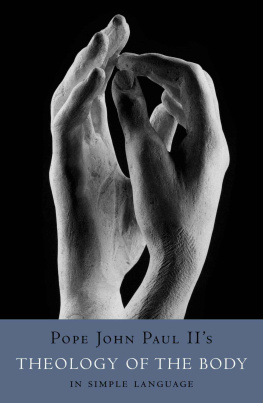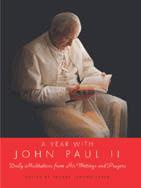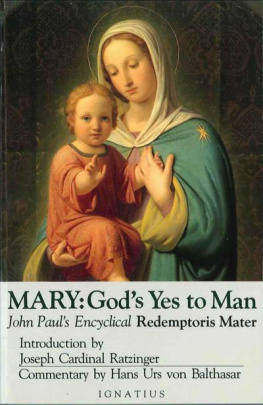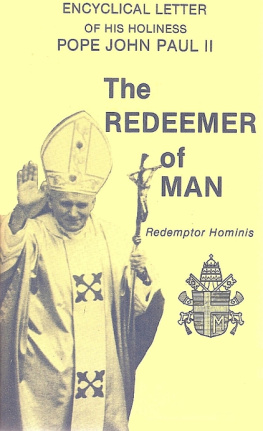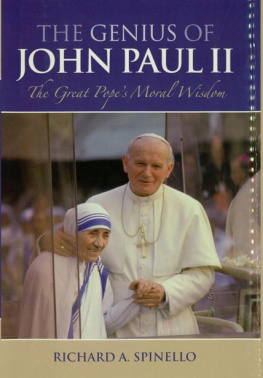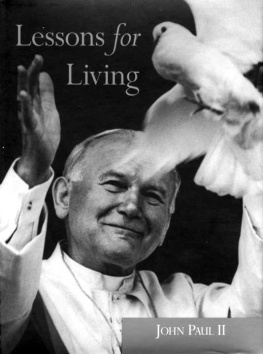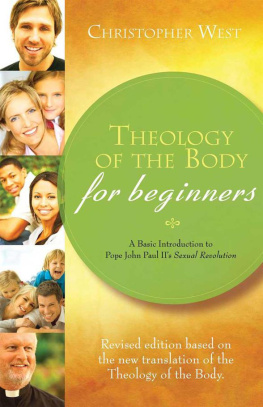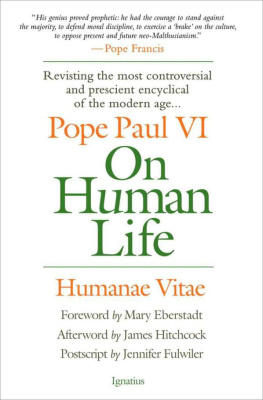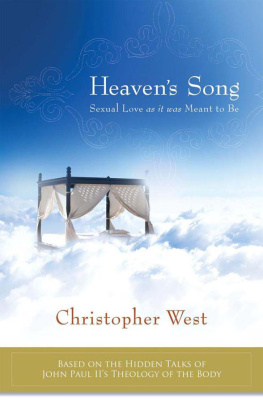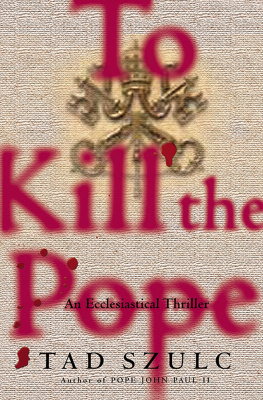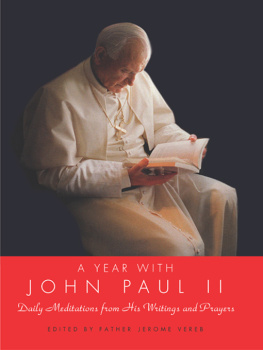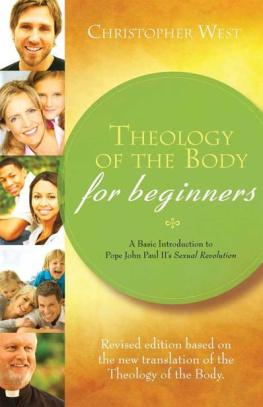Pope John Paul IIs
Theology of the Body
Adapted into everyday English by Philokalia Books
Copyright 2008 Philokalia Books
Also available in paperback
All Scripture, unless otherwise noted, is taken from the Holy Bible, New International Version. Copyright 1973, 1978, 1984 by the International Bible Society. Used by permission of Zondervan. All rights reserved.
Scripture marked ESV is from the English Standard Version
Scripture marked NKJV is from the New King James Version
CONTENTS
I. Body and Gift
II. Purity of Heart
III. Heaven and Earth
I.
BODY AND GIFT
Reflections on Creation
God created Adam and Eve that there
may be great love between them, reflecting
the mystery of Divine unity.
S T. T HEOPHILUS OF A NTIOCH
The Beginning
The family is the first community, the basic building block of society and the Church. It has been so from the beginning.
The Lord Jesus uses just this phrase, from the beginning, in his talk about marriage recorded in the gospels of Matthew and Mark. What exactly did he mean by the beginning?
Lets take a close look at the exchange between Jesus and the Pharisees.
Some Pharisees came to him to test him. They asked, Is it lawful for a man to divorce his wife for any and every reason? Havent you read, he replied, that at the beginning the Creator made them male and female, and said, For this reason a man will leave his father and mother and be united to his wife, and the two will become one flesh? So they are no longer two, but one. Therefore what God has joined together, let man not separate. Why then, they asked, did Moses command that a man give his wife a certificate of divorce and send her away? Jesus replied, Moses permitted you to divorce your wives because your hearts were hard. But it was not this way from the beginning. (Mt. 19:38; see also Mk. 10:29)
Jesus doesnt answer the Pharisees question on their level. He didnt approve of their legalistic approach to moral issues, and he wasnt about to get caught up in fruitless arguments.
Instead, he refers back to the beginningto the words of Genesis, which the Pharisees knew by heart. The Pharisees were looking to test Christ. By going back to Gods original blueprint for marriage, he evades their trap and leaves them speechless.
If we want to learn about Gods plan for marriage, we have to begin at the beginning. The full text of Genesis 1:27, which Jesus summarizes, says, So God created man in his own image, in the image of God he created him; male and female he created them. Jesus draws a connection between this verse and Genesis 2:24For this reason a man will leave his father and mother and be united to his wife, and the two will become one flesh.
By linking these two verses, and adding, So they are no longer two, but one. Therefore what God has joined together, let man not separate, Christ casts new light on the one flesh union of marriage.
A man and a woman dont become one flesh on their own, Christ saysGod unites them. Marriage is not a mere social institution. It is a holy union instituted by God.
Jesus words, what God has joined together, let man not separate, are clear. In light of them, we can see that the book of Genesis contains the principle that marriage is a divine union that cannot be dissolved by man.
At this point, it may seem like weve reached a conclusion. But it would be foolish to think we can ever exhaust the rich meaning of Scriptureeven of so simple a phrase as from the beginning. By twice referring his questioners back to the beginning, Jesus asked them to ponder deeply the way God created human beings, precisely as male and female.
Lets put ourselves in the place of Jesus questioners. But rather than seeking to test Christ, let us meditate on these things, leaning in and looking for wisdom.
In Gods Image
The first verse Jesus quoted, Genesis 1:27, comes from the first story of mans creation. This version, told in the first chapter of Genesis, places man within a seven-day cycle of creation.
The other verse Jesus referred to, Genesis 2:24, comes from the second story of mans creation. These two stories are separate but complementary. Starting in Genesis 2, the second account tells the story of Adam and Eve. In detail, it describes mans creation, his original innocence, his happiness, and also his first fall. It extends through the first verse of Genesis 4, where we read about the birth of Adam and Eves first child. The story of mans creation is then complete.
The first creation story covers the creation of the entire universe, from galaxies and stars down to plants and animals. Leading up to mans creation, theres a steady progression of activitybut then God comes to a pause.
He looks over all the living creatures hes made, and declares them good. Then, God decrees,
Let us make man in our image, in our likeness, and let them rule over... all the earth So God created man in his own image, in the image of God he created him; male and female he created them. (Gen. 1:2627)
This first creation story is brimming with theological implications. This is especially true of the way it defines mans relationship to God.
Man is part of the natural world, but, at the same time, he is set apart from it. He isnt like the other animalshe alone is made in Gods likeness. Thats why hes given stewardship over the earth.
This also explains why man cannot be defined in purely naturalistic or materialistic terms. Yes, man is a physical being. But already, on the first page of the Bible, we learn that man cant be explained as a merely physical beinga collection of cells, tissues, and organs. Human beings transcend the categories of chemistry and biology.
Ultimately, man can only be understood in relation to God. This great mystery of creationthat we are created in Gods imageis the key reference point for understanding all aspects of humanity, including our sexuality. This is illustrated by the very next verse: God blessed them and said to them, Be fruitful and increase in number; fill the earth and subdue it (Gen. 1:28). Thus, to the mystery of mans creation is added the blessing of procreation.
The first chapter of Genesis is the basis for a Christian understanding of manit tells the truth about who we are as human beings. It is of the utmost importance to all theology, especially the theology of the body.
Original Innocence
The second story of mans creation comes from a different perspective than the first. While the first creation account is objective, the second is subjectiveinstead of defining man from the outside, it describes life as human beings experience it, from the inside. But the two accounts relate to each other, because all of our subjective experiences correspond to the objective reality that we are created in Gods image.
The second creation story is distinguished by its separate account of the creation of the first woman, Eve.
So the Lord caused the man to fall into a deep sleep; and while he was sleeping, he took one of the mans ribs and closed up the place with flesh. Then the Lord God made a woman from the rib he had taken out of the man, and brought her to the man. The man said, This is now bone of my bones and flesh of my flesh; she shall be called woman, for she was taken out of man. For this reason a man will leave his father and mother and be united to his wife, and they will become one flesh. The man and his wife were both naked, and they felt no shame. (Gen. 2:2125)
Immediately following this passage, Genesis 3 begins with its account of the Fall of man, linked with that mysterious tree called the tree of the knowledge of good and evil (Gen. 2:17). From then on, Adam and Eve find themselves in an entirely new situationtheir world is turned upside down.
In the state of original innocence, Adam and Eve had no knowledge of good and evil. Then, at the prompting of the evil one (in the form of the serpent), they disobeyed Gods instruction and ate the fruit of the tree of knowledge. In the second situation, our first parents experienced sin and its consequences.
Next page
